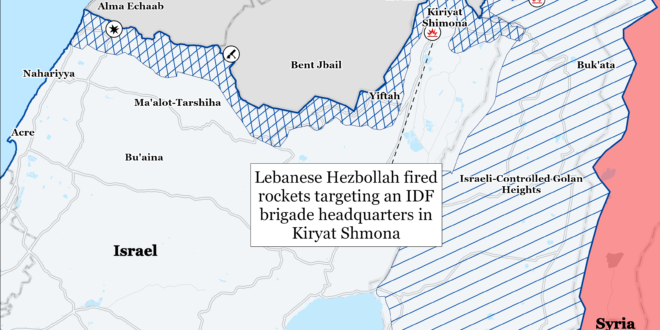Israeli Prime Minister Benjamin Netanyahu sent a delegation led by Mossad Director David Barnea to Doha, Qatar on July 5 to continue ceasefire talks.[i] Barnea met with Qatari Prime Minister Mohammed bin Abdulrahman al Thani on July 5 to build discussions on the ceasefire proposal Hamas submitted to Israel on July 2.[ii] An anonymous Israeli official told The New York Times that the Israeli delegation is engaging in preliminary talks before advancing to more “substantive” talks.[iii] US and Israeli officials described this new round of ceasefire talks as a breakthrough after weeks of stalled negotiations but the officials warned that these talks do not guarantee a ceasefire deal.[iv] Netanyahu told the Israeli negotiation team prior to its departure to Doha that the war in the Gaza Strip will end “only after achieving all of [the war] goals.”[v] An anonymous US official cautioned that “[t]here’s still work to do” on the ceasefire.[vi]
ADD NOTE
TWEET
Israel’s post-war plan for the Gaza Strip remains unclear as negotiations resume in Doha. Saudi Foreign Minister Faisal bin Farhan said that Saudi Arabia supports an international force under the auspices of the United Nations to support the Palestinian Authority in the Gaza Strip following the end of the war.[vii] Hamas has promised to prevent the deployment of foreign forces in the Gaza Strip.[viii]
Hezbollah leader Hassan Nasrallah discussed Israel-Hamas ceasefire talks and security developments in the Gaza Strip with a senior Hamas delegation in Beirut on July 5.[ix] Hamas Political Bureau Deputy Chairman Khalil al Hayya led the Hamas delegation. Nasrallah and the delegation discussed Hamas’ political efforts to reach a ceasefire agreement with Israel. The Hamas delegation expressed appreciation for Hezbollah’s support to Palestinian fighters in the Gaza Strip.
The Hamas delegation separately held meetings with a senior Houthi delegation and a delegation from the Islamic Resistance in Iraq, without providing additional details.[x]
Iran held its second round of its presidential election between ultraconservative hardliner candidate Saeed Jalili and moderate candidate Masoud Pezeshkian on July 5.[xi] The Iranian Election Headquarters extended the voting deadline from 1800 to 0000 local time, likely to try to increase voter turnout.[xii] This action is not unprecedented; the regime has previously extended voting hours during both presidential and parliamentary elections, including during the June 28 first round presidential election.[xiii] The Interior Ministry will likely announce the final election results in the morning local time of July 6. CTP-ISW will publish analysis of the results on July 6.
Iran is continuing to promote greater financial and monetary cooperation with Russia to try to undermine Western sanctions. Central Bank of Iran Governor Mohammad Reza Farzin traveled to St. Petersburg, Russia, on July 3 to attend a financial conference.[xiv] Farzin called on BRICS members to form a financial institution similar to the Financial Action Task Force (FATF).[xv] The FATF blacklisted Iran in February 2020 for failing to implement anti-money laundering and counter-terrorist financing policies.[xvi] Farzin also called on Russia, China, and Iran to use their national currencies—rather than the US dollar—in economic transactions.[xvii] Farzin invited Russia to join the Asian Clearing Union, which is a payment arrangement in which the central banks of member states “settle payments for intra-regional transactions…on a net multilateral basis.”[xviii] Iran, Bangladesh, Bhutan, India, the Maldives, Myanmar, Nepal, Pakistan, and Sri Lanka currently comprise the Asian Clearing Union. Belarus applied to join the Asian Clearing Union in May 2023.[xix]
Key Takeaways:
- Iran: Iran held its second round of its presidential election between ultraconservative hardliner candidate Saeed Jalili and moderate candidate Masoud Pezeshkian on July 5.
- Ceasefire Negotiations: Israeli Prime Minister Benjamin Netanyahu sent a delegation led by Mossad Director David Barnea to Doha, Qatar on July 5 to continue ceasefire talks.
- Gaza Strip: Hamas tactics and Shujaiya’s dense, urban terrain are presenting challenges for the IDF, in some cases requiring that Israeli infantry clear building multiple times.
- Lebanon: Hezbollah leader Hassan Nasrallah discussed Israel-Hamas ceasefire talks and security developments in the Gaza Strip with a senior Hamas delegation in Beirut on July 5.
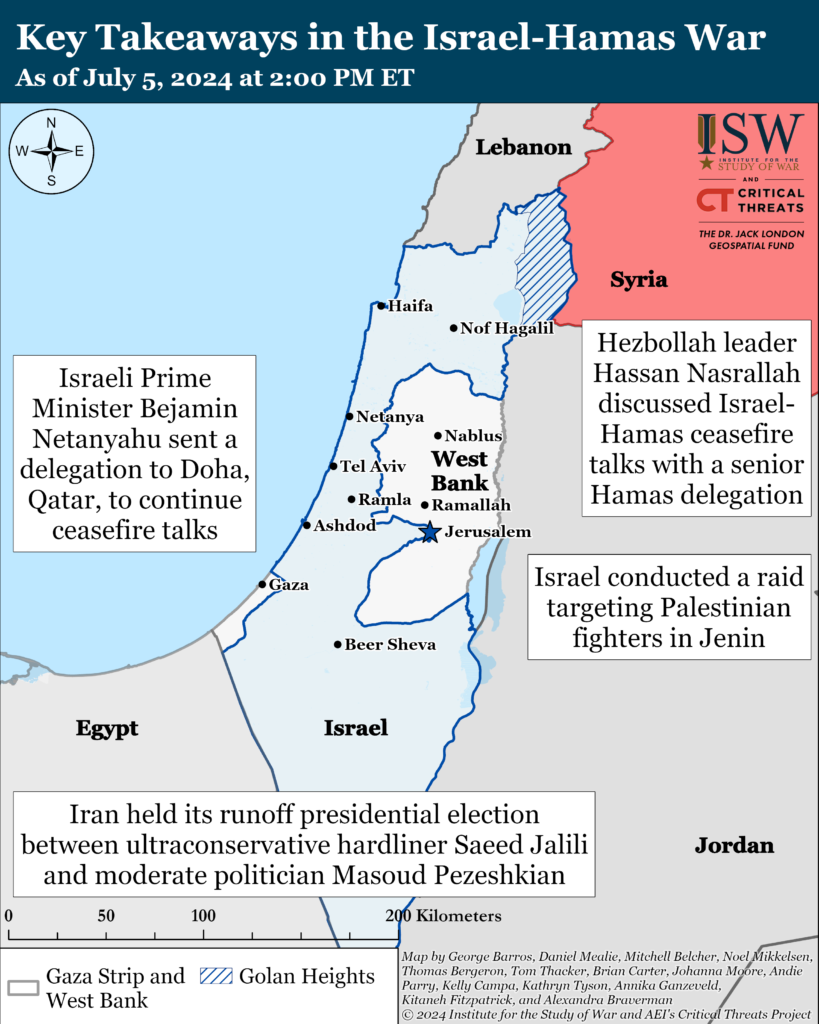
Gaza Strip
Axis of Resistance objectives:
Erode the will of the Israeli political establishment and public to sustain clearing operations in the Gaza Strip
Reestablish Hamas as the governing authority in the Gaza Strip
The 98th Division continued its operations to degrade a partially reconstituted Hamas battalion in Shujaiya, Gaza City on July 5.[xx] Hamas tactics and Shujaiya’s dense, urban terrain are presenting challenges for the IDF, in some cases requiring that Israeli infantry clear building multiple times.[xxi] The IDF has located approximately 2 kilometers of tunnels in Shujaiya that have not been destroyed. The IDF estimates that a “few dozen” Palestinian fighters remain in Shujaiya. These fighters shadow Israeli forces as the IDF operates in Shujaiya and emerge from tunnels to attack Israeli forces. The IDF reported that the 98th Division has killed between 80 and 100 Palestinian fighters in Shujaiya since the operation began on June 27.[xxii]
Hamas and Palestinian Islamic Jihad (PIJ) conducted separate attacks targeting Israeli forces operating in Shujaiya. Hamas conducted a complex attack in which they fired a thermobaric rocket at Israeli forces barricaded in a building and then detonated an improvised explosive device (IED) as the Israeli forces withdrew from the area.[xxiii]
The 99th Division continued clearing operations along the Netzarim Corridor on July 5.[xxiv] Israeli forces killed Palestinian fighters operating along the corridor, including one fighter who was attempting to plant an IED. Hamas and the Popular Resistance Committees conducted a joint rocket attack targeting an Israeli outpost on the corridor.[xxv] PIJ mortared Israeli forces located in an unspecified area of the Netzarim Corridor.[xxvi]
The 162nd Division killed “dozens” of Palestinian fighters and destroyed several buildings rigged with explosives during clearing operations in Rafah on July 5.[xxvii] Hamas claimed its fighters conducted a complex attack on an IDF outpost southeast of Tel al Sultan, killing and wounding IDF soldiers there.[xxviii] Hamas fighters targeted the outpost with mortar fire, anti-personnel rockets, sniper fire, and small arms fire. A Hamas sniper shot an Israeli soldier in Tal Zorob, west of Rafah City.[xxix] The al Aqsa Martyrs’ Brigades—the self-proclaimed militant wing of Fatah—and PIJ claimed separate mortar attacks on Israeli forces at the Egypt-Rafah border crossing.[xxx]
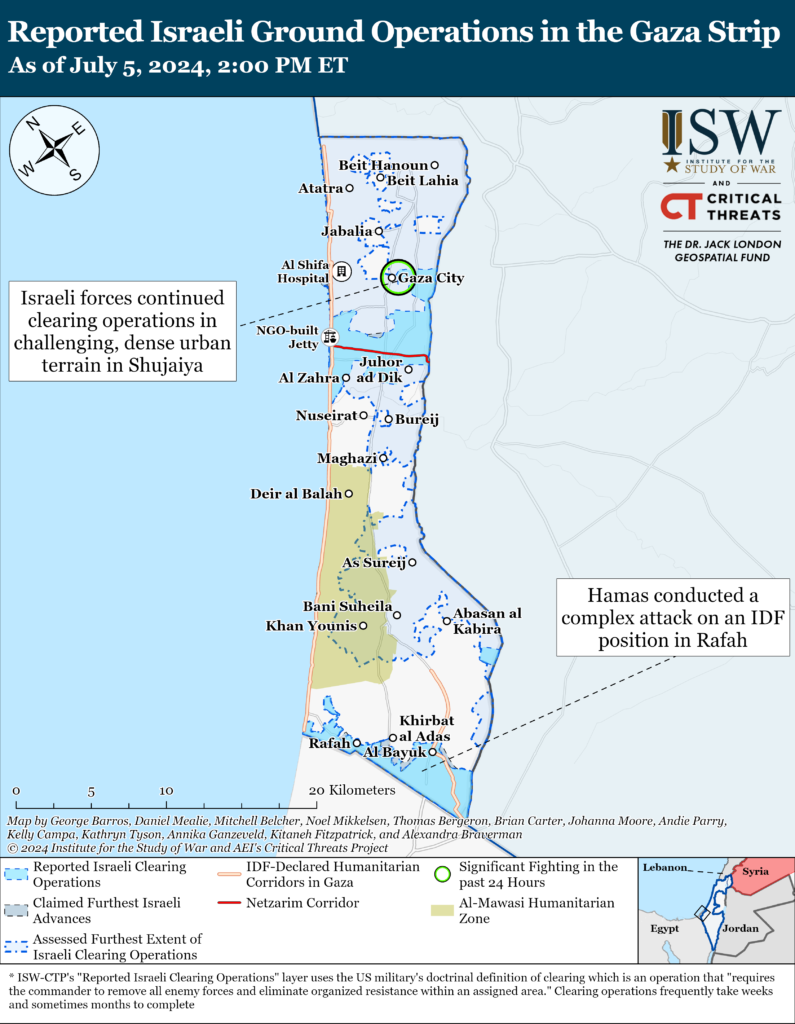
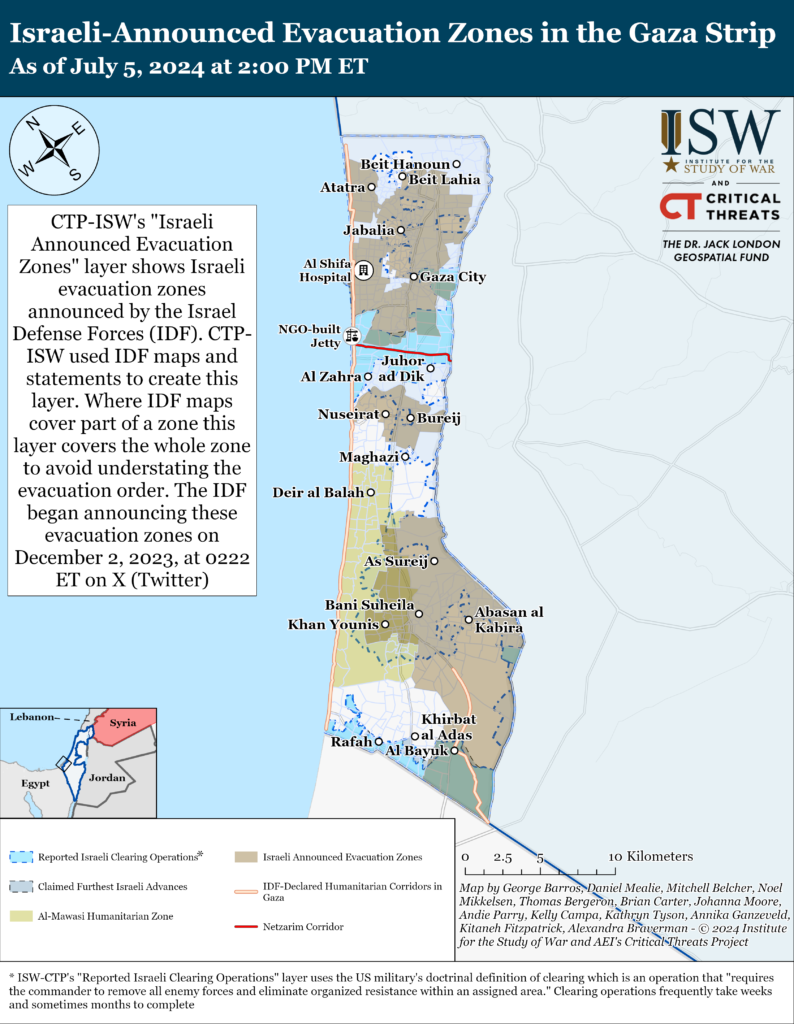
The al Aqsa Martyrs’ Brigades and PIJ targeted the town Nahal Oz and an IDF site located nearby in a rocket attack on July 5.[xxxi]

West Bank
Axis of Resistance objectives:
Establish the West Bank as a viable front against Israel
Israel conducted a raid targeting Palestinian fighters in Jenin on July 5. The IDF raided a building in Jenin and engaged Palestinian fighters in the area.[xxxii] The IDF killed seven fighters during the raid, including two PIJ fighters responsible for an IED attack that killed an IDF captain and wounded 16 other soldiers in Jenin on June 27.[xxxiii] The IDF killed a third PIJ fighter on July 3 who had been involved in the June 27 attack in Jenin.[xxxiv] Hamas mourned the three of its fighters killed during the raids on July 5.[xxxv] The IDF also conducted a drone strike targeting fighters in Jenin.[xxxvi] Hamas, Palestinian Islamic Jihad (PIJ), and the al Aqsa Martyrs’ Brigades conducted separate small arms and improvised explosive device (IED) attacks targeting Israeli forces in Jenin.[xxxvii]
Israeli forces have engaged Palestinian fighters in seven locations in the West Bank since CTP-ISW’s last data cut-off on July 4.[xxxviii] Unspecified fighters fired small arms and detonated IEDs targeting Israeli forces in Beita, near Nablus.[xxxix]

This map is not an exhaustive depiction of clashes and demonstrations in the West Bank.
ADD NOTE
TWEET
Southern Lebanon and Golan Heights
Axis of Resistance objectives:
Deter Israel from conducting a ground operation into Lebanon
Prepare for an expanded and protracted conflict with Israel in the near term
Expel the United States from Syria
Lebanese Hezbollah conducted at least five attacks into northern Israel on July 5.[xl]
Hamas Political Bureau Chairman Ismail Haniyeh discussed the Israel-Hamas ceasefire and developments in the Israel-Hamas War with Jamaa al Islamiya Secretary General Mohammed Taqoush on July 5.[xli] Haniyeh praised Jamaa al Islamiya for supporting Palestinian fighters in the Gaza Strip. Both Hamas and Jamaa al Islamiya are offshoots of the Muslim Brotherhood.[xlii]
Hezbollah’s Executive Council head Hashem Saif al Din made comments on July 5 threatening further attacks against Israel after the IDF killed a senior Hezbollah commander on July 3.[xliii] Saif al Din made the comments at a funeral service for Hezbollah commander Mohammed Nama Nasr. Nasr led the Aziz Unit, which is responsible for Hezbollah operations in southwestern Lebanon.[xliv] Hezbollah said that Nasr joined the group in 1986 and fought in the Israel-Hezbollah war in 2006.[xlv] Hezbollah added that Nasr participated in the Iranian-led military interventions into Iraq and Syria to fight the ”Islamic State” and Syrian opposition. Nasr joined the Aziz Unit in 2016 and oversaw anti-tank and rocket fire into Lebanon.[xlvi] Hezbollah conducted a large-scale drone and rocket attack into northern Israel on July 4 in response to Nasr’s death.[xlvii]
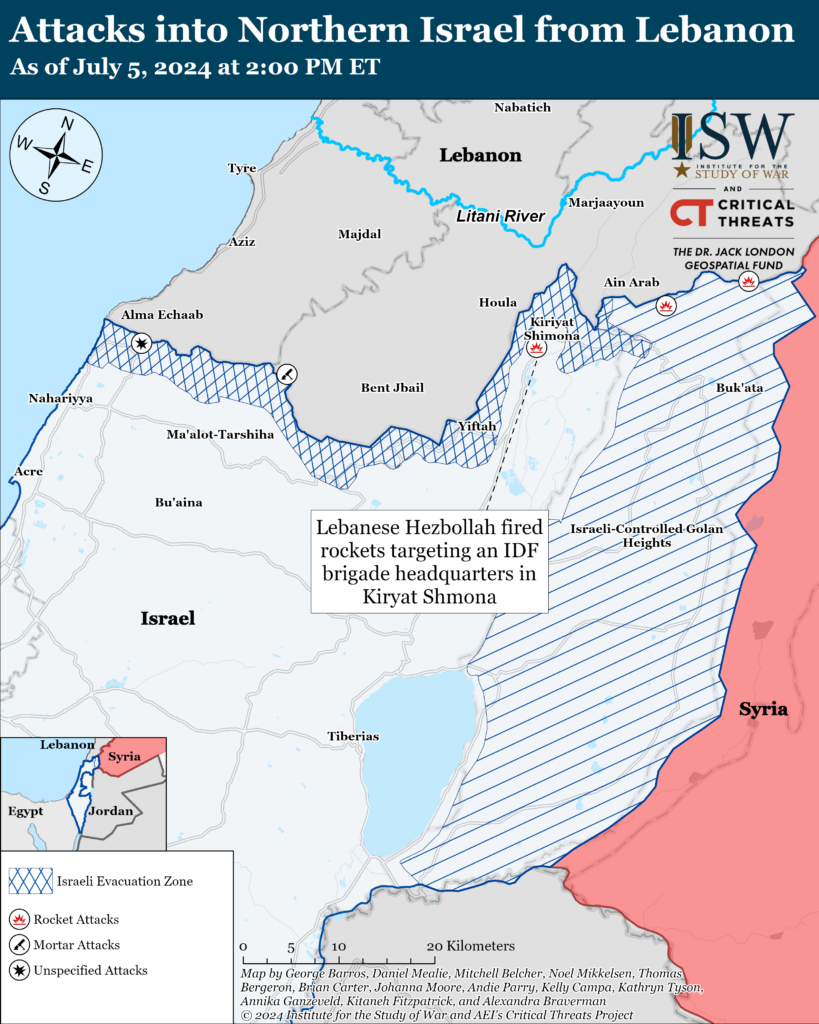
Recorded reports of attacks; CTP-ISW cannot independently verify impact.
Iran and Axis of Resistance
Kurdistan Democratic Party Leader Masoud Barzani met separately with the Iranian and Turkish ambassadors to Iraq in Baghdad on July 5, likely to discuss recent Turkish military operations in Iraqi Kurdistan.[xlviii] The Turkish Army recently increased its troop presence and established security checkpoints in Dohuk Province, Iraqi Kurdistan Region, to combat the Kurdistan Workers’ Party (PKK).[xlix] Barzani and Turkish Ambassador to Iraq Anil Bora Inan discussed economic and political relations between Turkey, Iraq, and Iraqi Kurdistan.[l] Inan called for resolving political problems in Iraq with “dialogue and understanding.” Iranian-backed Iraqi militia Kataib Hezbollah condemned Barzani’s visit to Baghdad in a statement on July 4, claiming that his visit reflects the United States’ “wicked” role in Iraqi politics.[li] Faylaq al Waad al Sadiq separately warned on June 25 that it would “expel” Turkish forces from Iraq if Turkey does not withdraw.[lii] Faylaq al Waad al Sadiq reportedly has ties to Iranian-backed Iraqi militias Asaib Ahl al Haq and Harakat Hezbollah al Nujaba.[liii] Iranian-backed Iraqi militias have previously attacked Turkish forces in Iraq in response to Turkish political and military activity in Iraq.[liv]
Barzani also met with former Parliament Speaker Mohammad al Halbousi, Sovereignty Alliance head Khamis al Khanjar, and other unspecified Sunni political leaders in Baghdad on July 4 to discuss the parliament speaker elections.[lv] The Iraqi Federal Supreme Court dismissed Halbousi as parliament speaker in November 2023.[lvi] Iraqi Parliamentarians have failed to elect a new parliament speaker and Shia politician Mohsen al Mandalawi has served as the acting parliament speaker since November 2023. Barzani’s meeting with Halbousi and Khanjar comes amid reports that Khanjar’s Sovereignty Alliance may rejoin Halbousi’s National Progress Alliance to present a single candidate for the speakership.[lvii]
Hamas political leader Ismail Haniyeh discussed the war in Gaza with the Secretary General of the Muslim Brotherhood in Jordan, Sheikh Murad al Adhaileh, on July 4.[lviii] Hamas readout stated Haniyeh discussed progress in ceasefire negotiations with Ahadileh.[lix] Hamas was founded as an offshoot of the Muslim Brotherhood.[lx]
Local Syrian opposition media reported that several vehicles carrying Kataib Hezbollah members entered Syria from Iraq via the Albu Kamal crossing.[lxi] The report stated that Kataib Hezbollah members were being transported to Damascus ”discreetly”.
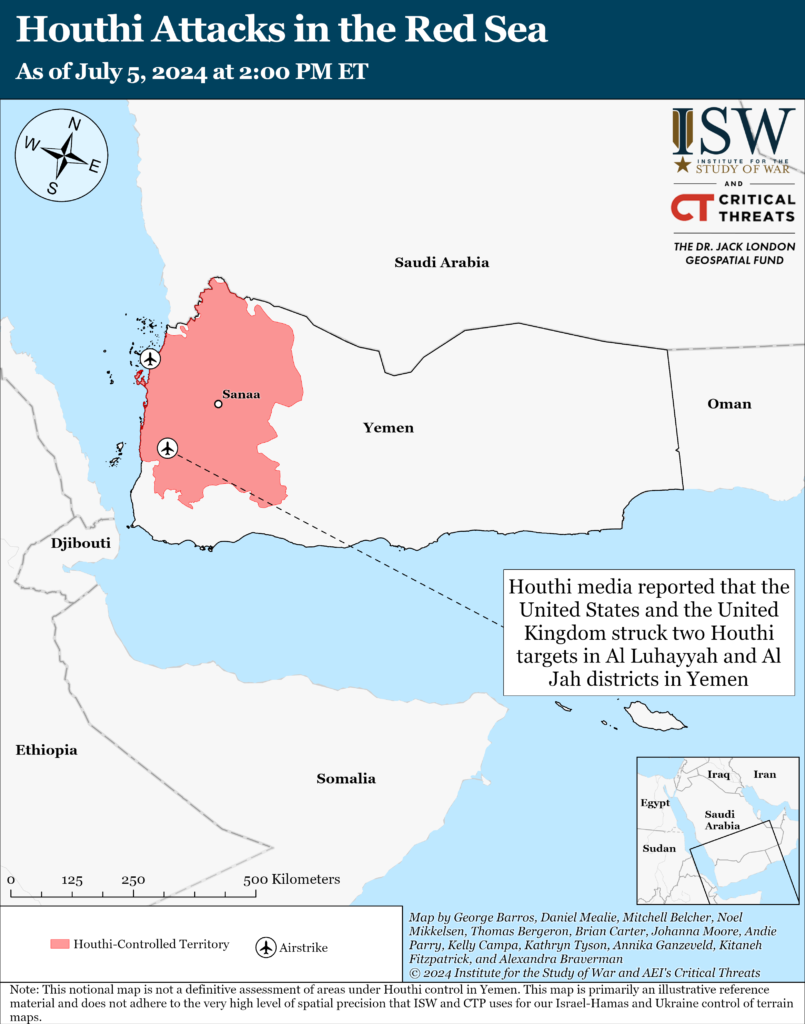
US CENTCOM said that it has destroyed two Houthi unmanned surface vessels in the Red Sea and one Houthi radar site in Yemen on July 4.[lxii] CENTCOM stated these unmanned surface vessels, and the radar site presented a threat to US, coalition, and merchant vessels in the region. Houthi media reported that the United States and the United Kingdom struck two Houthi targets in Yemen.[lxiii]
Palestinian Islamic Jihad Secretary General Ziad al Nakhalah briefed Houthi supreme leader Abdulmalik al Houthi on the ongoing developments in the Gaza Strip.[lxiv] The pair also discussed the ceasefire efforts. Abdulmalik reiterated his continued support for the Palestinian fighters during the meeting.
 Eurasia Press & News
Eurasia Press & News
